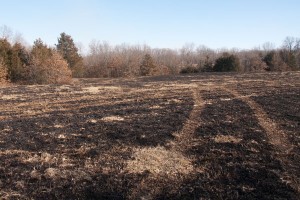A fire started in our neighbor’s pasture which then spread to our pasture and winter hay supply. I won’t go into the messy details but will instead  focus on the opportunity that has been presented. The opportunity to read up on and learn the benefits and consequences of burnt land and most importantly, how can I use it to my advantage.
focus on the opportunity that has been presented. The opportunity to read up on and learn the benefits and consequences of burnt land and most importantly, how can I use it to my advantage.
First I read articles by folks describing the benefits of burning pastures on a timed schedule. Excess residue is burned away opening the canopy for new growth. Sunlight easily reaches the soil to promote seed germination. The left over ash from burnt matter provides stimulants for the new growth. Burning doesn’t necessarily harm grasses due to their deep root systems. Forbs, having a more shallow root system could be retarded though. Burning is also a way of managing woody species without the use of chemicals.
Other folks warn off burning and I’m joining the “other folks” group. Burning isn’t the only way to manage invasive plant species in pastures. Planned rotational grazing of cattle is an excellent tool. Cattle trample sprouts and use their leaves as forage. Heavily graze cattle in a specific area if you need to open up the grass canopy and promote a specific forage species. Burning off pastures can decrease soil’s water holding capacity and promote moisture loss through evaporation. Instead of burning organic matter away, rotate cattle through paddocks and let them press residue into the soil surface as they walk. This will shield the soil surface from evaporation and also protect organisms living in the soil. Organisms live off of organic matter and make more organic matter. This same organic matter then increases plant quality and growth. Sun and air temperature heat up exposed soil and drives soil life away; soil life that wasn’t already destroyed by the fire.
Opportunity also lies in observing the recovery of the land. What will grow back and how quickly? What seeds in the seed bed have been waiting to emerge? How long before soil life returns? Opportunity abounds.